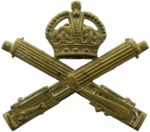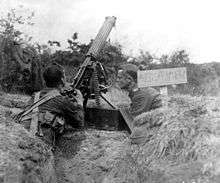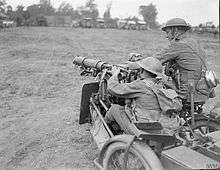Machine Gun Corps
The Machine Gun Corps (MGC) was a corps of the British Army, formed in October 1915 in response to the need for more effective use of machine guns on the Western Front in the First World War. The Heavy Branch of the MGC was the first to use tanks in combat and was subsequently turned into the Tank Corps, later called the Royal Tank Regiment. The MGC remained in existence after the war until it was disbanded in 1922.
| Machine Gun Corps | |
|---|---|
 Cap badge of the Machine Gun Corps. | |
| Active | 1915–1922 |
| Country | |
| Branch | |
| March | Quick: The Happy Clown |
| Engagements | First World War |
History


At the outbreak of the First World War in August 1914, the tactical potential of machine guns was not appreciated by the British Armed Forces. The prevalent attitude of senior ranks at the outbreak of the Great War can be summed up by the opinion of an officer (albeit expressed a decade earlier) that a single battery of machine guns per army corps was a sufficient level of issue.
Despite the evidence of fighting in Manchuria (1905 onwards) the army therefore went to war with each infantry battalion and cavalry regiment containing a machine gun section of just two guns.
These organic (embedded) units were supplemented in November 1914 by the formation of the Motor Machine Gun Service (MMGS) administered by the Royal Artillery, consisting of motor-cycle mounted machine gun batteries.
A machine gun school was also opened in France.
After a year of warfare on the Western Front it was self-evident that to be fully effective–in the opinion of former sceptics-that machine guns must be used in larger units and some commanders advocated crewing them with specially trained men who not only thoroughly conversant with their weapons but who understood how they should be best deployed for maximum effect. To achieve this, the Machine Gun Corps was formed in October 1915 with Infantry, Cavalry, and Motor branches, followed in 1916 by the Heavy Branch. A depot and training centre was established at Belton Park in Grantham, Lincolnshire, and a base depôt at Camiers in France.

- The Infantry Branch was by far the largest and was formed by the transfer of battalion machine gun sections to the MGC. These sections were grouped into Brigade Machine Gun Companies, three per division. New companies were raised at Grantham. In 1917, a fourth company was added to each division. In February and March 1918, the four companies in each division were formed into a Machine Gun Battalion.
- The Guards Division formed its own machine gun support unit, the Guards Machine Gun Regiment.
- The Cavalry Branch consisted of Machine Gun Squadrons, one per cavalry brigade.
- The Motor Branch was formed by absorbing the MMGS and the armoured car squadrons of the recently disbanded Royal Naval Armoured Car Service. It formed several types of units: motor cycle batteries, light armoured motor batteries (LAMB) and light car patrols. As well as motor cycles, other vehicles used included Rolls-Royce and Ford Model T cars.
- The Heavy Section was formed in March 1916, becoming the Heavy Branch in November of that year. Men of this branch crewed the first tanks in action at Flers, during the Battle of the Somme in September 1916. In July 1917, the Heavy Branch separated from the MGC to become the Tank Corps, later called the Royal Tank Regiment.
The MGC saw action in all the main theatres of war, including France and Belgium, Palestine, Mesopotamia, Egypt, Salonika, East Africa and Italy. In its short history, the MGC gained an enviable record for heroism as a front line fighting force. Indeed, in the latter part of the war, as tactics changed to defence in depth, it commonly served well in advance of the front line. It had a less enviable record for its casualty rate. Some 170,500 officers and men served in the MGC, with 62,049 becoming casualties, including 12,498 killed, earning it the nickname 'the Suicide Club'.
While the undeniable bravery and self-sacrifice of the corps stands testament to the men and their regimental esprit de corps it is also a symptom of the fixed belief on the part of senior commanders that machine guns were confined to a marginal if useful role, that of an adjunct to massed rifle fire, ignoring the proven potential of this weapon in the indirect role (in effect rifle-calibre fire employed as ultra-short artillery.) By correctly setting up the same weapons more commonly used in the direct role (over open sights) the delivering of accurate and sustained fire at high elevation became less an art than a science that could reliably deliver plunging fire at approximately twice the maximum effective range of hand-held weapons of identical calibre, but not so convincingly a belief to hold that the machine gunners were in effect hiding behind the front lines while uselessly firing into the air, making a show instead of dying beside riflemen whose weapons used practically identical ammunition.
This conviction may explain–from both sides–the persistence with which machine gunners were placed in exposed positions where their fire was only marginally effective but enemy troops could be seen to fall victim to it, and the great personal bravery with which those same men fought when the same enemy concentrated their forces against the greater threat represented by an unsupported sandbag emplacement.
As stated by Paul Cornish in Machine Guns and the Great War:
'The theory behind this technique had long been understood... as early as 1908... the mathematical work required to provide a reliable basis for the conduct of such fire was carried out by a group of British enthusiasts at the Hythe musketry school... However, it was 1915 before such fire was successfully carried out in the field...'
Cornish goes on 'To conduct such fire the proposed target would be located... the relative position of the machine gun relative to it would be determined with ruler and protractor.. calculations would be made to determine the gun's potential cone of fire and the trajectory of its bullets (an important consideration if firing over the head of friendly troops). A clinometer, combined with a graduated elevation dial fitted to the tripod would be employed to set the gun to the correct elevation...'
The obvious complexities and the exacting preparations - in effect identical to those of artillery gunners - may have seemed arcane and pointless to those who carried - or whose men carried - rifles firing the same ammunition but could neither see (or more importantly imagine) the terminal effect of a long-range barrage.
When properly employed it was unarguably a devastating deterrent, as witnessed by those who took the trouble to seek out the areas interdicted but for those who took the trouble to do so were often regarded uncritical advocates of novel, untried tactics. This extract from the Vickers machine gun article clearly conveys the concept:
The Vickers was used for indirect fire against enemy positions at ranges up to 4,500 yards (2.5 miles or 4.1 kilometres). This plunging fire was used to great effect against road junctions, trench systems, forming up points, and other locations that might be observed by a forward observer, or zeroed in at one time for future attacks, or guessed at by men using maps and experience. Sometimes a location might be zeroed in during the day, and then attacked at night, much to the surprise and confusion of the enemy.
While in the more sustained direct fire role, properly supported:
Perhaps the most incredible was the action by the 100th Company of the Machine Gun Corps at High Wood on August 24, 1916. This company had ten Vickers guns, and it was ordered to give sustained covering fire for 12 hours onto a selected area 2000 yards away in order to prevent German troops forming up there for a counter-attack while a British attack was in progress... [a] hundred new barrels were used up, and every drop of water in the neighbourhood, including the men’s drinking water and contents of the latrine buckets, went up in steam to keep the guns cool. And in that 12-hour period the ten guns fired a million rounds...
(Weapons & War Machines - Ian V. Hogg & John Batchelor)
Towards the end of the Great War some if not all deeply-entrenched attitudes were changing, and not only on the part of British and Commonwealth personnel. Following the extensive barrage fire at Vimy and Messines a demonstration was held on the dunes at Camiers by request of Field Marshal Sir Douglas Haig, Commander-in-Chief (C-in-C) of the British Expeditionary Force on the Western Froht, who insisted all his Corps commanders attend.
French observers were treated to a similar demonstration, after which the concept was swiftly introduced into the French Army where it was embraced as a means to economise on artillery shells with the extraordinary assertion the results were more demoralising 'by means of continuity' than the result of shelling. Subsequently a machine gun school was established near the site of both demonstrations and machine gun barrages were successfully employed used by the French forces at Meuse and Verdun.
At the end of hostilities, the MGC was re-organised in a smaller form as many of its soldiers returned to civilian life. However, the Corps continued to see active service notably in the Russian Civil War; the Third Anglo-Afghan War, and the ongoing conflict in the Northwest Frontier of India.
The MGC also served prominently in the British force that occupied parts of Germany in the period between the Armistice of 1918 and the Versailles Peace Treaty of 1919 as its equipment and training made it possible for a relatively small garrison to control a large population but by 1920 the headquarters in Belton Park was closed and the War Office began to dispose of the many buildings.[1]
In 1922 the Machine Gun Corps was disbanded as a cost-cutting measure.
Victoria Crosses
The following members of the Machine Gun Corps have been awarded the Victoria Cross (VC), the highest and most prestigious award for valour in the face of the enemy that can be awarded to British and Commonwealth forces.
- Herbert George Columbine, 1918, Hervilly Wood, France
- Arthur Henry Cross, 1918, Ervillers, France
- John Reginald Noble Graham, 1917, Istabulat, Mesopotamia
- Allan Ebenezer Ker, 1918, near St. Quentin, France
- David Stuart McGregor, 1918, near Hoogemolen, Belgium
- Harold Sandford Mugford, 1917, Monchy-le-Preux, France
- William Allison White, 1918, Gouzeaucourt, France
Machine Gun Corps Memorial, London
A memorial to the 15,552 wartime fatalities of the Machine Gun Corps was unveiled on 10 May 1925 by the Duke of Connaught, at Hyde Park Corner in London. It features a bronze statue by Francis Derwent Wood in the Renaissance style, depicting the youthful David after his defeat of the giant Goliath, an event described in the Book of Samuel; on lower plinths flanking the figure are two bronze models of Vickers machine guns, wreathed in laurels.[2]
A short service of remembrance known as the Annual Observance is held on the second Saturday in May at the Memorial, which is organised by the Machine Gun Corps Old Comrades' Association. On Remembrance Sunday, the second Sunday in November, there is also a wreath laying ceremony held in conjunction with the ceremony at the nearby Royal Artillery Memorial.[3]
Notable personnel
- Category:Machine Gun Corps soldiers
- Category:Machine Gun Corps officers
References
- Buildings Archived 2005-08-30 at the Wayback Machine
- Historic England. "Machine Gun Corps Memorial (1226874)". National Heritage List for England. Retrieved 26 February 2018.
- "The Machine Gun Corps - Remembrance". www.machineguncorps.co.uk. Machine Gun Corps Old Comrades' Association. Retrieved 26 February 2018.
- MGC Old Comrades Association
- Time Team Series 20 Episode 01 The Forgotten Gunners of WWI
Bibliography
- Hutchison, G. S., Machine Guns: Their History and Tactical Employment (Being also a History of the Machine Gun Corps, 1916–1922). London: Macmillan, 1938.
- Russell, Arthur, With the Machine Gun Corps from Grantham to Cologne. London : Dranes, 1923.
- Crutchley, C. E., Machine Gunner: 1914–1918. Purnell Book Services, 1975.
- Stevens, F. A., The Machine Gun Corps: A Short History. Tonbridge: F. A. Stevens, 1981.
- Coppard, George, With a Machine Gun to Cambrai. Cassell Military Paperbacks, 1999.
- Weapons & War Machines - Ian V. Hogg & John Batchelor - Pheobus - 1976 ISBN 0-7026-0008-3
- Cornish, Paul, Machine Guns and the Great War. Pen & Sword Ltd 2009 ISBN 978-1-84884-047-8
External links
| Wikimedia Commons has media related to Machine Gun Corps. |
- The Machine Gun Corps Old Comrades' Association
- "The end as the beginning". Family history. Historical Eye. 2011. — Private Alfred Adams, MGC, killed at Oppy-Gavrelle in 1917